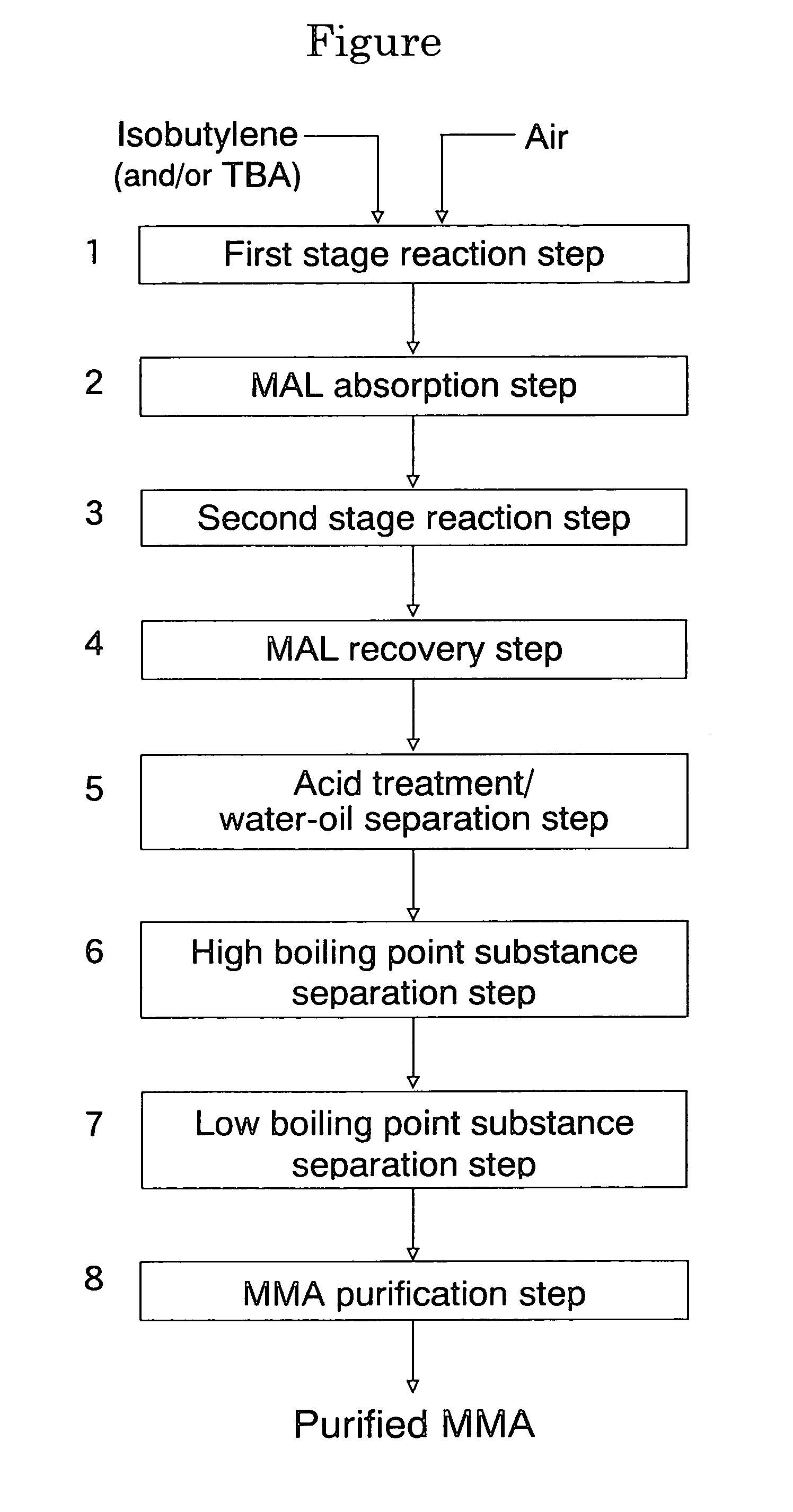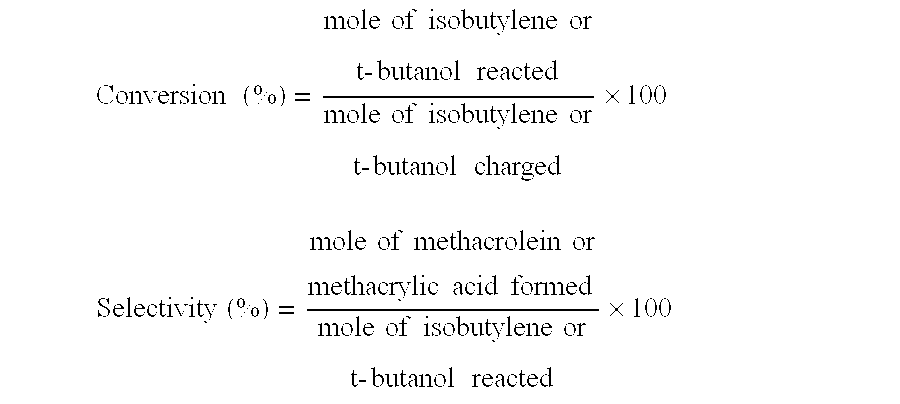Oxide catalyst composition
a technology of oxide catalyst and composition, which is applied in the preparation of carbonyl compounds, physical/chemical process catalysts, metal/metal-oxide/metal-hydroxide catalysts, etc., can solve the problems of increased production cost, discoloration of polymers, and inability to cause discoloration, etc., to achieve high reduction resistance, high selectivity for methacrolein, and high thermal stability
- Summary
- Abstract
- Description
- Claims
- Application Information
AI Technical Summary
Benefits of technology
Problems solved by technology
Method used
Image
Examples
example 1
[0136]An oxide catalyst composition having a structure (in terms of atomic ratios of constituent metallic elements, relative to twelve atoms of the total of molybdenum and tungsten) represented by the formula:
Mo12Bi1.6Ce0.4 K0.1Cs0.4Fe1.5CO8.0Sb0.7
was prepared as follows.
[0137]Ammonium heptamolybdate in an amount of 350.0 g was dissolved in 1,700 g of water having a temperature of about 50° C., to thereby obtain an aqueous solution. To the obtained aqueous solution was added 16.8 g of antimony trioxide, thereby obtaining an aqueous suspension containing molybdenum and antimony. The obtained aqueous suspension was heated to 90° C. while stirring, and then 65.0 g of a 30% by weight aqueous hydrogen peroxide solution was slowly added thereto while stirring. The resultant mixture turned to assume bright yellow while foaming, and the state of the mixture became a solution. The stirring of the thus obtained aqueous solution was further continued for about 30 minutes at 90° C. Then, the so...
example 2
[0165]In Example 2, oxide catalyst composition having the formulations as shown in Table 1 was prepared in substantially the same manner as in Example 1, except that the amounts of metallic elements were adjusted so as to comply with the formulation indicated in Table 1. In addition, the final firing of the catalyst was conducted at the temperature indicated in Table 1.
[0166]The evaluation of the initial performances of the oxide catalyst composition and the stringent condition test were performed in the same manner as in Example 1. The initial performances of the catalyst composition are shown in Table 2 and the performances of the catalyst composition after the stringent condition test are shown in Table 3. In addition, a methyl methacrylate monomer was produced by the direct ML-to-MMA process in the same manner as in Example 1, and a methyl methacrylate polymer was produced using the thus produced methyl methacrylate monomer. The APHA value of the methyl methacrylate monomer and ...
example 3
[0167]An oxide catalyst composition having a structure (in terms of atomic ratios of constituent metallic elements, relative to twelve atoms of the total of molybdenum and tungsten) represented by the formula:
Mo9.5W2.5Bi1.7Ce0.4K0.2Cs0.2Fe1.0Co6.5Ni1.0Sb0.5
was prepared as follows.
[0168]103.6 g of ammonium paratungstate was dissolved in 1,900 g of water having a temperature of about 60° C., and 267.1 g of ammonium heptamolybdate was added thereto, thereby obtaining an aqueous solution. To the obtained aqueous solution was added 11.6 g of antimony trioxide, thereby obtaining an aqueous suspension containing molybdenum, tungsten and antimony. The obtained aqueous suspension was heated to 90° C. while stirring, and then 50.0 g of a 30% by weight aqueous hydrogen peroxide solution was slowly added thereto while stirring. The resultant mixture turned to assume bright yellow while foaming, and the state of the mixture became a solution. The stirring of the thus obtained aqueous solution wa...
PUM
| Property | Measurement | Unit |
|---|---|---|
| temperature | aaaaa | aaaaa |
| temperature | aaaaa | aaaaa |
| temperature | aaaaa | aaaaa |
Abstract
Description
Claims
Application Information
 Login to View More
Login to View More - R&D
- Intellectual Property
- Life Sciences
- Materials
- Tech Scout
- Unparalleled Data Quality
- Higher Quality Content
- 60% Fewer Hallucinations
Browse by: Latest US Patents, China's latest patents, Technical Efficacy Thesaurus, Application Domain, Technology Topic, Popular Technical Reports.
© 2025 PatSnap. All rights reserved.Legal|Privacy policy|Modern Slavery Act Transparency Statement|Sitemap|About US| Contact US: help@patsnap.com



